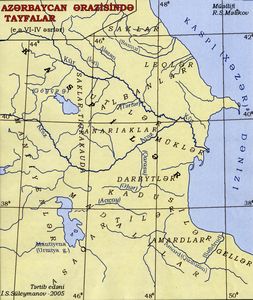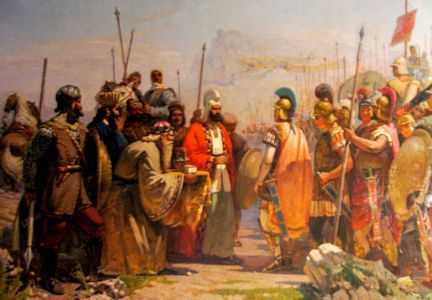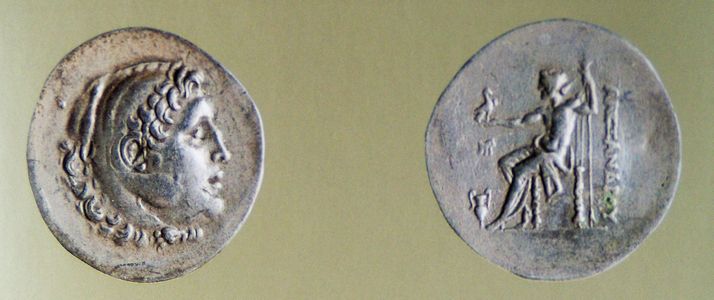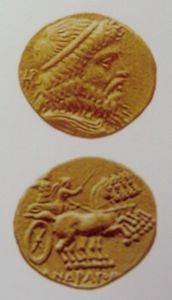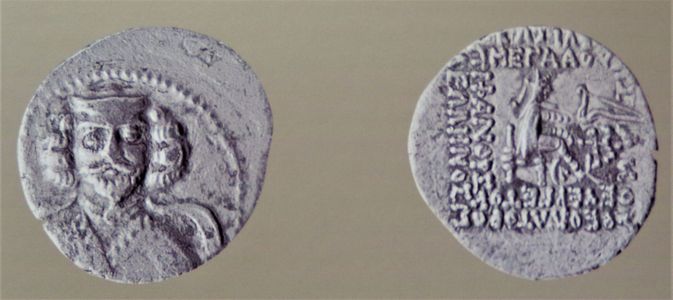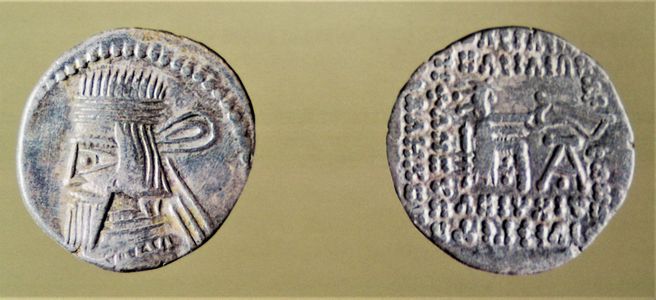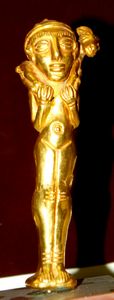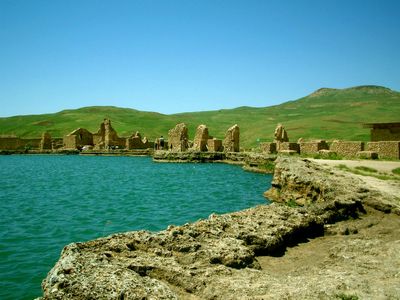FORMATION OF THE STATE
After the dissolution of Media (Mada), southern territories of Azerbaijan had become a part of the Achaemenid Empire. The empire consisted of several provinces governed by satraps, and one of such provinces covered the territories to the south of Araz, known as Minor Media. In IV century B.C., satrap Atropates had started governing the province independently. Soon after the empire’s collapse, Atropates had established bilateral relations with Macedonians and regained his satrap status in 328 B.C. After the death of Alexander the Great (323 B.C.) and disintegration of Macedonian Empire Minor Media (Mada) became independent and known as the state of Atropatene.
Atropatene covered the entire territory of Southern Azerbaijan and the large part of modern Azerbaijan Republic. Atropatene maintained close trade relations with the states of Caucasus, Volga, Middle Asia, India, Minor Asia and Mesopotamia, as well as Black Sea and Mediterranean Sea regions. The state had its’ own money. Since the III century B.C., gold and silver Atropatene coins had been commonly used in Ecbatana – one of the state’s largest economic centers. On the obverse sides of these coins there was an (A.T.P.) monogram, meaning <ATPоpatnνη> - Atropatene in the Hellenic alphabet.
In the course of the centuries, the name of the state had gone through a linguistic transformation and turned into a present-day name of Azerbaijan.
POLITICAL HISTORY
Atropatene had managed to maintained its independence in the struggles with Seleucid and Parthian empires and taken side of the Parthians during their wars with Roman Empire.
In 36 B.C., the Roman triumvir Mark Antony and his ally Artavasdes II (king of Media Atropatene in 59-20 B.C.) had launched a military campaign to invade Atropatene. In spite of the fact that there were just 50 thousand people in the Atropatene’s army, including 50 thousands in infantry and 10 thousands in cavalry, Romans had lost the battle with a heavy toll and were forced to retreat. After that war, bilateral relations between Atropatene and Roman Empire were established.
Political system of Atropatene was based on hereditary monarchy. The state’s social hierarchy consisted of aristocracy, clergy (magis), peasants, artisans, merchants and slaves.
In 20 A.D., Atropatene had been invaded by Parthian Empire and lost its political independence.
POPULATION AND ECONOMY
Atropatene was a multi-ethnic country inhabited by Matiens (Hurrians), Sagartians, Cadusii, Gillites, Utis, Magis, etc.
Main economic activities of the Atropatene people were horticulture (mainly wheat and barley growing) and winegrowing. According to antique sources, the country had exceptionally fertile lands. Thus, it was possible to make up to 40 litres of wine from a single grapevine, and collect more than 52 kilograms of figs from one common fig tree. The same authors narrated that Atropatene was famous for the well-developed animal husbandry, especially horse breeding traditions. Breeding of livestock, camels and horses was well developed in the Caspiane province. Moreover, Caspians were specialized in producing salted fish and taking it to the markets of Ecbatana. They also made fish oil and produced a thick glue from the fish’s entrails.
Ammianus Marcellinus wrote: “People of this country make Median oil. If you spread such oil on an arrowhead and discharge the arrow on a target, the arrowhead will instantly flame up strongly upon reaching the target if a bowstring is pulled slightly, and burn out if flying fast. Attempts to choke fire with water may only lead to the fire’s mending as it can be only choked with an earth”. Therefore, the oil was used both in the everyday life and wars. According to Marcellinus, the oil was mixed with a special herb and left to get thicker. Then the oil thickness was further increased with the help of a natural fuel called nafta by locals.
Atropatene was known as a country with well-developed handicrafts, and had rich natural deposits of the different materials required for handicraft production. Towns like Gazaka, Fraaspa, Fanaspa and Aganzana had been the country’s handicraft and trade centers. Both domestic and external trading had been favoured by the fact that there were several crossborder transport corridors passing through the country’s territory. For example, Ekbatan and Gazaka (Atropatene capital) used to be key towns on the transportation route of Bactrian, Indian and Chinese goods to the Pontian (Black Sea), Western Asia and Mediterranean regions. Ekbatan-Gazaka international transport corridor was laid along Caspian seacoast into Albania and then further to the north.
Money played important role in the trade. Oldest discovered examples are the coins minted on behalf of Alexander the Great. Later, the country started minting its own coins with portraits and names of the Atropatene kings embossed on their obverses.
CULTURE
Atropatene had left rich cultural heritage. As seen from the town remains discovered by archaeological expeditions, the country had rich town building culture. Usually towns had emerged along important trade routes and around large sanctuaries, or had been built in the fulfilment of royal decrees. Towns played a role of the state’s administrative, economic, cultural and ideological centers. Stone columns and tiles were widely used in the design of the buildings. As Atropatene existed during Hellenistic period and was largely inspired by the Hellenic culture, Hellenic alphabet and language had been commonly used in the country.
ZOROASTRIANISM
People of Atropatene had been practicing Zoroastrianism. There is even an assumption that Zoroaster was born in the territory of Azerbaijan in the middle of VII century, and declared himself a prophet in 595 B.C. Zoroastrianism is a faith centred in a dualistic cosmology of good and evil, truth and lie, light and dark. According to Zoroastrians, forces of goodness were headed by Ahura Mazda, and the forces of evil were represented by Ahriman (Angra Mainyu). The main Zoroastrian temple was located in Gazaka, Atropatene. There were eternal fires burning in the temple’s alters. Atropatene had been the Zoroastrianism’s center during Sasanian period. When acceding to the throne, every new Sasanian kings used to make their first pedestrian pilgrimage to Adurgushnasp – Zoroastrian temple located in the Atropatene town Shiz. The religion’s main book “Avesta” used to be a primary collection of different Zoroastrian texts, including religious and ritual precepts, cosmogonic and eschatological notions, holy anthems which praised various gods, prayers, ethical norms, myths, epics, legends, etc.
